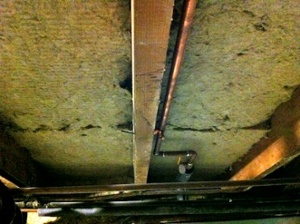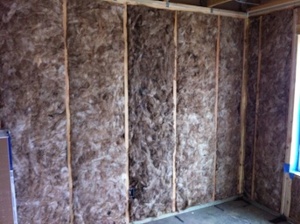Green Curmudgeons, Architects, and Outlawing Batt Insulation

 Yesterday I observed an interesting discussion on Twitter. Carl Seville, the Green Building Curmudgeon, posted a link to his article suggesting that maybe we should just ban all batt insulation. Greg La Vardera, an architect who really understands the building envelope, responded that Carl shouldn’t lump mineral wool insulation in the same category as fiberglass, referring to his article, What You Don’t Know about Mineral Wool Will Make You Look Stupid.
Yesterday I observed an interesting discussion on Twitter. Carl Seville, the Green Building Curmudgeon, posted a link to his article suggesting that maybe we should just ban all batt insulation. Greg La Vardera, an architect who really understands the building envelope, responded that Carl shouldn’t lump mineral wool insulation in the same category as fiberglass, referring to his article, What You Don’t Know about Mineral Wool Will Make You Look Stupid.
Yesterday I observed an interesting discussion on Twitter. Carl Seville, the Green Building Curmudgeon, posted a link to his article suggesting that maybe we should just ban all batt insulation. Greg La Vardera, an architect who really understands the building envelope, responded that Carl shouldn’t lump mineral wool insulation in the same category as fiberglass, referring to his article, What You Don’t Know about Mineral Wool Will Make You Look Stupid.
Now, Carl takes his moniker seriously and responded with all his curmudgeonliness. You can tell from the title of Greg’s article that he also has strong beliefs. Hey, we don’t call it Building Science Fight Club for nothing, you know! My purpose here is not to detail their discussion, though, because you can go to Twitter and read it all there. Their handles are @GreenCurmudgeon and @lamidesign respectively.
I’ve written my share of articles about batt insulation here—and even gotten in trouble for one of them—and my take has been similar to Carl’s. I haven’t called for a ban on batts, but the overall installation quality of what I’ve seen has caused me to recommend sprayed or blown types of insulation over batts most of the time. I wouldn’t have a problem putting batt insulation in my own home because I could do it myself or provide enough instruction and supervision to make sure the contractor did it properly, to Grade I installation quality.
Almost all of the batt insulation I’ve seen installed is made of fiberglass. I’ve recently seen some mineral wool batt insulation installed, and it’s not like the low-density fiberglass batts that get installed in most places. The photo above is of Roxul mineral wool batts in the cavities between floor joists. Notice that there are no steel pins holding it up. It’s friction fit and really filling the space with compression or incomplete fill. In that house, it was installed just for soundproofing between the basement and the living space above, and I don’t know how well it’d do over the long-term because gravity, although the weakest of the fundamental forces of nature, is quite persistent.
Also, please take a look at Greg’s article on mineral wool batts. He shows a lot of great photos of batts being cut accurately with saws and fitted into framing cavities. I really do believe that mineral wool batts aren’t in the same category as the standard fiberglass batts that get installed poorly in so many houses.
But let’s give some credit to fiberglass, too. I wrote recently about a Grade I fiberglass batt insulation job in Nashville, Tennessee, and the photo at right is from that house. I think that two things can make it easier for fiberglass batts to be installed well, too:
fiberglass, too. I wrote recently about a Grade I fiberglass batt insulation job in Nashville, Tennessee, and the photo at right is from that house. I think that two things can make it easier for fiberglass batts to be installed well, too:
- Higher density
- No paper facing
The former is happening more and more as codes and energy efficiency programs push builders to look for ways to get more R-value in the same space. The latter is happening because energy codes don’t require paper facing in above-grade walls in most climate zones anymore.
Of course, the main thing that needs to happen is training of installers and enforcement by building inspectors. When insulation contractors have better batt products to work with, the training and enforcement parts get easier, too.
So, should batt insulation be outlawed, as Carl asks? My answer is no.
This Post Has 14 Comments
Comments are closed.

Thanks for the mention of the
Thanks for the mention of the wild twitter discussion going on yesterday. To clarify, I don’t actually suggest that we ban batt insulation, I simply pose the question, wrapping up with the suggestion that if it isn’t outlawed then the installation of it should be carefully managed and limited to qualified people.
As to my conversation with Greg, he was quite insistent that I immediately rewrite my post to exclude mineral wool. I don’t disagree with him that mineral wool batts are better than fiberglass, and could even be considered “good” batts, but I saw no reason to rewrite my piece, but he kept insisting. Finally I got him to calm down and comment on the post.
I also agree with you that it is possible to do a good job installing batts, I’ve seen it, although it is not very common.
Allison, thanks for sticking
Allison, thanks for sticking up for the good old fiberglass batt. We’re a fiberglass installer up in Chattanooga and have found ourselves battling the hype surrounding blown and sprayed insulation more and more recently.
We maintain that each one is a great product, provided that it’s installed correctly. Outlawing fiberglass batts would be sort of like finding out what type of car most drunk drivers drive, and outlawing that type of car. The real solution involves higher standards among fiberglass installers, as well as better education among builders, inspectors, and consumers that is informed more by science than by marketing.
All insulation systems can
All insulation systems can only perform as well as their installer, but some systems are more prone to installer error than others. Insulation is too important and we shouldn’t skimp by installing batt insulation. Batts in all forms, are the lowest common denominator and should be avoided.
For example, the following video is supposed to highlight the use of rockwool, but frankly I’m not impressed. Despite being installed in ideal jobsite conditions and under scrutiny of the camera there are still visible gaps and cracks in the install.
http://blog.postgreenhomes.com/2012/04/04/new-double-stud-wall-assembly-with-rock-wool-smart-vapor-retarder/
I thank Carl for tolerating
I thank Carl for tolerating my twitter bomb with good humor.
My point is that while we all know anything can be installed poorly, the advantage of Mineral Wool is it is so much easier to install well. As I state in my article I believe there is no insulation sprayed, blown, or otherwise that will give you as full, complete, and free of voids as Mineral Wool for a like amount of effort.
And the most important issue is American already builds with batts. Moving to a product like Mineral Wool that will improve performance and quality is an easy change. Blows and sprays – that is a difficult switch, obviously. They have been around for years. If they were an alternate the industry was willing to use they would have replaced fiberglass long ago.
As Allison noted, floors are
As Allison noted, floors are a real challenge with fiberglass batts. Mineral wool seem to be a better option. Is mineral wool cost competitive with “fg done right” (assuming that’s even possible for floors) when you factor in labor and all?
Next house I build will be
Next house I build will be spray foamed, I’ve seen the results. HUGE difference !!
higher density & no
higher density & no paper facing..works for me!
Healthy debate, I’d like to
Healthy debate, I’d like to think the customer gets the correct insulation regardless of what it is.
very healthy debate,
very healthy debate, insulating your home will make a big difference in your energy consumption and reflect in reducing home energy bills. Regardless of the type of insulation, if it is installed correctly and used in conjunction with other energy efficient products you also reduce your carbon foot print by reducing your energy consumption
I’m a bit concerned about the
I’m a bit concerned about the cruelty to the mineral sheep. 🙂
It is not all the installer’s
It is not all the installer’s fault. One of our best insulation subs told me a few years ago they had stopped installing bats ~ because the contractors were refusing to pay the cost of a proper installation and were finding someone else to do it their way!!
I convinced the sub I expected the best and they did it for me.
I work installing cellulose
I work installing cellulose insulation dense pac into walls & cellings–use foam just in to rim joist–cellulose is the “Greenest of the Green”
R/C Wisconsin
For me spray foam is always
For me spray foam is always the best way to go. It is more efficient anyway, simply because you can reach places that would otherwise have had sub-par insulation using other methods.
Wood beams need to be kept
Wood beams need to be kept dry and allowed to breathe – so is it wise to cover them in whole or part with spray foam? And doesn’t it knock your estimated house values sideways with the fears surrounding it’s use.
As for batts a 50mm / 2″ fibreglass roll laid along the beams/ or the rafter channels is just has good (all the rest is just hot air talk / or to get technical see the laws on diminishing insulation returns) and what about weight per sq-metre of insulation tests.
The spokesperson the insulation trade does not need is Bud Abbot of Lou Costello and Bud Abbot fame speaking about trapped air acting as a wonderful insulant, and little Lou butts in too state: “If you can’t trap air in a sunken submarine – then how on earth do you expect to do it in a house, using that stuff,” (boom,boom)